Pharmacology > QUESTIONS & ANSWERS > RN PHARMACOLOGY PROCTORED TEST BANK _ 100% VERIFIED ANSWERS | RN PHARMACOLOGY PROCTORED TEST BANK - (All)
RN PHARMACOLOGY PROCTORED TEST BANK _ 100% VERIFIED ANSWERS | RN PHARMACOLOGY PROCTORED TEST BANK - ANSWERS & RATIONALE _Grade A
Document Content and Description Below
ATI Pharmacology Proctored Test Bank ATI Pharmacology Proctored Exam, Test Bank(100 % Of 313 Verified Questions anALL CORRECT Answers), GRADED A+ 1. 1) A nurse is caring for a client with hyperpara... thyroidism and notes that the client's serum calcium level is 13 mg/dL. Which medication should the nurse prepare to administer as prescribed to the client? 1. Calcium chloride 2. Calcium gluconate 3. Calcitonin (Miacalcin) 4. Large doses of vitamin D 2. 2.) Oral iron supplements are prescribed for a 6-year-old child with iron deficiency anemia. The nurse instructs the mother to administer the iron with which best food item? 1. Milk 2. Water 3. Apple juice 4. Orange juice 3. 3.) Salicylic acid is prescribed for a client with a diagnosis of psoriasis. The nurse monitors the client, knowing that which of thefollowing wouldindicatethe presence of systemic toxicity from this medication? 1. Tinnitus 2. Diarrhea 3. Constipation 4. Decreased respirations 4. 4.) The camp nurse asks the children preparing to swim in the lake if they have applied sunscreen. The nurse reminds the children that chemical sunscreens are most effective when applied: 1. Immediately before swimming 2. 15 minutes before exposure to the sun 3. Immediately before exposure to the sun 4. At least 30 minutes before exposure to the sun 5. 5.) Mafenide acetate (Sulfamylon) is prescribed for the client with a burn injury. When applying the medication, the client complains of local discomfort and burning. Which of the following is the most appropriate nursing action? 1. Notifying the registered nurse 2. Discontinuing the medication 3. Informing the client that this is normal 4. Applying a thinner film than prescribed to the burn site 3. Calcitonin (Miacalcin) Rationale: The normal serum calcium level is 8.6 to 10.0 mg/dL. This clientis experiencing hypercalcemia.Calciumgluconateandcalciumchloridearemedicationsusedforthe treatment of tetany, which occurs as a result of acute hypocalcemia. In hypercalcemia, largedoses of vitamin D need to be avoided. Calcitonin, a thyroid hormone, decreases the plasma calcium level by inhibiting bone resorption and lowering the serum calciumconcentration. 4. Orange juice Rationale: Vitamin C increases the absorption of iron by the body. The mother should be instructedtoadminister themedication witha citrus fruit or a juicethatis highin vitaminC. Milkmayaffectabsorptionoftheiron.Waterwillnotassistinabsorption. Orange juice contains a greater amount of vitamin C than apple juice. 1. Tinnitus Rationale: Salicylic acid is absorbed readily through the skin, and systemic toxicity (salicylism) canresult.Symptoms includetinnitus,dizziness,hyperpnea,andpsychological disturbances. Constipation and diarrhea arenot associated with salicylism. 4. Atleast 30 minutes beforeexposureto thesun Rationale: Sunscreens aremost effective whenapplied atleast 30 minutes beforeexposureto thesunso thattheycan penetratetheskin. All sunscreens should be reappliedafter swimming or sweating. 3. Informing the clientthatthis is normal Rationale: Mafenideacetateisbacteriostaticforgram-negativeandgram-positiveorganisms andis usedtotreatburns toreducebacteria presentinavascular tissues. Theclient shouldbeinformedthatthemedication will causelocaldiscomfortandburningand that this is a normal reaction; therefore options 1, 2, and 4 are incorrect Stuvia.com - The Marketplace to Buy and Sell your Study Material Downloaded by: jasminenturner1993 | [email protected] Distribution of this document is illegal Stuvia.com - The Marketplace to Buy and Sell your Study Material 6. 6.) The burn client is receiving treatments of topicalmafenideacetate(Sulfamylon)tothe site of injury. The nurse monitors the client, knowing that which of the following indicates that a systemic effect has occurred? 1.Hyperventilation 2.Elevated blood pressure 3.Local pain at the burn site 4.Local rash at the burn site 7. 7.) Isotretinoin is prescribed for a client with severe acne. Before the administration of this medication, the nurse anticipates that which laboratory test will be prescribed? 1. Platelet count 2. Triglyceride level 3. Complete blood count 4. White blood cell count 8. 8.) A client with severe acne is seen in the clinic and the health care provider (HCP) prescribes isotretinoin. The nurse reviews the client's medication record and would contact the (HCP) if the client is taking which medication? 1. Vitamin A 2. Digoxin (Lanoxin) 3. Furosemide (Lasix) 4. Phenytoin (Dilantin) 9. 9.) The nurse is applying a topical corticosteroid to a client with eczema. The nurse would monitor for the potential for increased systemic absorption of the medication if the medication were being applied to which of the following body areas? 1. Back 2. Axilla 3. Soles of the feet 4. Palms of the hands 10. 10.) The clinic nurse is performing an admission assessment on a client. The nurse notes that the client is taking azelaic acid (Azelex). Because of the medication prescription, the nurse would suspect that the client is being treated for: 1. Acne 2. Eczema 3. Hair loss 4. Herpes simplex 1. Hyperventilation Rationale: Mafenideacetateis acarbonicanhydraseinhibitorandcansuppress renalexcretion of acid, thereby causing acidosis. Clients receiving this treatment should be monitored for signs of an acid-base imbalance (hyperventilation). If this occurs, the medication should be discontinued for 1 to 2 days. Options 3 and 4 describe local rather thansystemic effects. Anelevatedblood pressuremay be expectedfromthe pain that occurs with a burn injury. 2. Triglyceride level Rationale: Isotretinoin can elevate triglyceride levels. Blood triglyceride levels should be measured before treatment and periodically thereafter until the effect on the triglycerides has beenevaluated. Options 1, 3, and4 donotneedtobemonitored specifically during this treatment. 1. Vitamin A Rationale: IsotretinoinisametaboliteofvitaminAandcanproducegeneralizedintensification of isotretinoin toxicity. Because of the potential for increased toxicity, vitamin A supplementsshouldbediscontinuedbeforeisotretinointherapy.Options2,3,and4 are not contraindicated with the use of isotretinoin. 2. Axilla Rationale: Topicalcorticosteroids canbeabsorbedintothesystemic circulation.Absorptionis higher from regions where the skin is especially permeable (scalp, axilla, face, eyelids, neck, perineum, genitalia), and lower from regions in which permeability is poor (back, palms, soles). 1. Acne Rationale: Azelaic acid is a topical medication used to treatmild to moderateacne. The acid appears to work by suppressing the growth of Propionibacterium acnes and decreasing theproliferation of keratinocytes. Options 2, 3, and 4 areincorrect. Downloaded by: jasminenturner1993 | [email protected] Distribution of this document is illegal Stuvia.com - The Marketplace to Buy and Sell your Study Material 11. 11.) The health care provider has prescribed silver sulfadiazine (Silvadene) for the client with a partialthickness burn, which has cultured positive for gramnegative bacteria. The nurse is reinforcing information to the client about the medication. Which statement made by the client indicates a lack of understanding about the treatments? 1. "The medication is an antibacterial." 2. "The medication will help heal the burn." 3. "The medication will permanently stain my skin." 4. "The medication should be applied directly to the wound." 12. 12.) A nurse is caring for a client who is receiving an intravenous (IV) infusion of an antineoplastic medication. Duringtheinfusion,theclientcomplains of pain at the insertion site. During an inspection of the site, the nurse notes redness and swelling and that the rate of infusion of the medication has slowed. The nurse should take which appropriate action? 1. Notify the registered nurse. 2. Administerpainmedicationtoreducethe discomfort. 3. Apply ice and maintain the infusion rate, as prescribed. 4. Elevate the extremity of the IV site, and slow the infusion. 13. 13.) The client with squamous cell carcinoma of the larynx is receiving bleomycin intravenously. The nurse caring for the client anticipates that which diagnostic study will be prescribed? 1. Echocardiography 2. Electrocardiography 3. Cervical radiography 4. Pulmonary function studies 14. 14.) The client with acute myelocytic leukemia is being treated with busulfan (Myleran). Which laboratory value would the nurse specifically monitor during treatment with this medication? 1. Clotting time 2. Uric acid level 3. Potassium level 4. Blood glucose level 3. "Themedication will permanently stain my skin." Rationale: Silver sulfadiazine (Silvadene) is an antibacterial that has a broad spectrum ofactivityagainstgram-negativebacteria,gram-positivebacteria,and yeast. Itis applied directly to the wound to assist in healing. It does not stain the skin. 1. Notify the registerednurse. Rationale: When antineoplastic medications (Chemotheraputic Agents) are administeredviaIV,greatcaremustbetakentopreventthemedicationfrom escaping into the tissues surrounding the injection site, because pain, tissue damage, and necrosis can result. The nurse monitors for signs of extravasation, such as redness or swelling at the insertion site and a decreasedinfusionrate.Ifextravasationoccurs,theregisterednurseneeds to be notified; he or she will then contact the health care provider. 4. Pulmonary function studies Rationale: Bleomycinisanantineoplasticmedication(ChemotheraputicAgents)that can cause interstitial pneumonitis, which can progress to pulmonary fibrosis. Pulmonary functionstudies along withhematological, hepatic, andrenal function tests need to be monitored. The nurse needs to monitor lung sounds fordyspnea andcrackles, which indicatepulmonary toxicity. The medication needs to be discontinued immediately if pulmonary toxicity occurs. Options 1, 2, and 3 are unrelated to the specific use of this medication. 2. Uric acidlevel Rationale: Busulfan (Myleran) can cause an increase in the uric acid level. Hyperuricemiacanproduceuricacidnephropathy,renalstones,andacute renal failure. Options 1, 3, and 4 are not specifically related to this medication. Downloaded by: jasminenturner1993 | [email protected] Distribution of this document is illegal Stuvia.com - The Marketplace to Buy and Sell your Study Material 15. 15.) The client with small cell lung cancer is being treated with etoposide (VePesid). The nurse who is assisting in caring for the client during its administration understands that which side effect is specifically associated with this medication? 1. Alopecia 2. Chest pain 3. Pulmonary fibrosis 4. Orthostatic hypotension 16. 16.) The clinic nurse is reviewing a teaching plan for the client receiving an antineoplastic medication. When implementing the plan, the nurse tells the client: 1. To take aspirin (acetylsalicylic acid) as needed for headache 2. Drink beverages containing alcohol in moderate amounts each evening 3. Consult with health care providers (HCPs) before receiving immunizations 4. That it is not necessary to consult HCPs before receiving a flu vaccine at the local health fair 17. 17.) The client with ovarian cancer is being treated with vincristine (Oncovin). The nurse monitors the client, knowing that which of the following indicates a side effect specific to this medication? 1. Diarrhea 2. Hair loss 3. Chest pain 4. Numbness and tingling in the fingers and toes 18. 18.) The nurse is reviewing the history and physical examination of a client who will be receiving asparaginase (Elspar), an antineoplastic agent. The nurse consults with the registered nurse regarding the administration of the medication if which of the following is documented in the client's history? 1. Pancreatitis 2. Diabetes mellitus 3. Myocardial infarction 4. Chronic obstructive pulmonary disease 4. Orthostatic hypotension Rationale: Asideeffectspecific toetoposideis orthostatichypotension. Theclient'sblood pressureis monitored during the infusion. Hair loss occurs with nearly allthe antineoplastic medications. Chest pain and pulmonary fibrosis are unrelated to this medication. 3. Consult with health care providers (HCPs) before receiving immunizations Rationale: Because antineoplastic medications lower the resistance of the body, clients must beinformednottoreceiveimmunizations withouta HCP's approval.Clients also need to avoid contact with individuals who have recently received a live virus vaccine. Clients need to avoid aspirin and aspirin-containing products to minimize the risk of [Show More]
Last updated: 1 year ago
Preview 1 out of 64 pages
Instant download

Instant download
Reviews( 0 )
Document information
Connected school, study & course
About the document
Uploaded On
Apr 10, 2022
Number of pages
64
Written in
Additional information
This document has been written for:
Uploaded
Apr 10, 2022
Downloads
0
Views
138

.png)
.png)
.png)
.png)
.png)
.png)
.png)
.png)
.png)
.png)
.png)

.png)

.png)
.png)

.png)

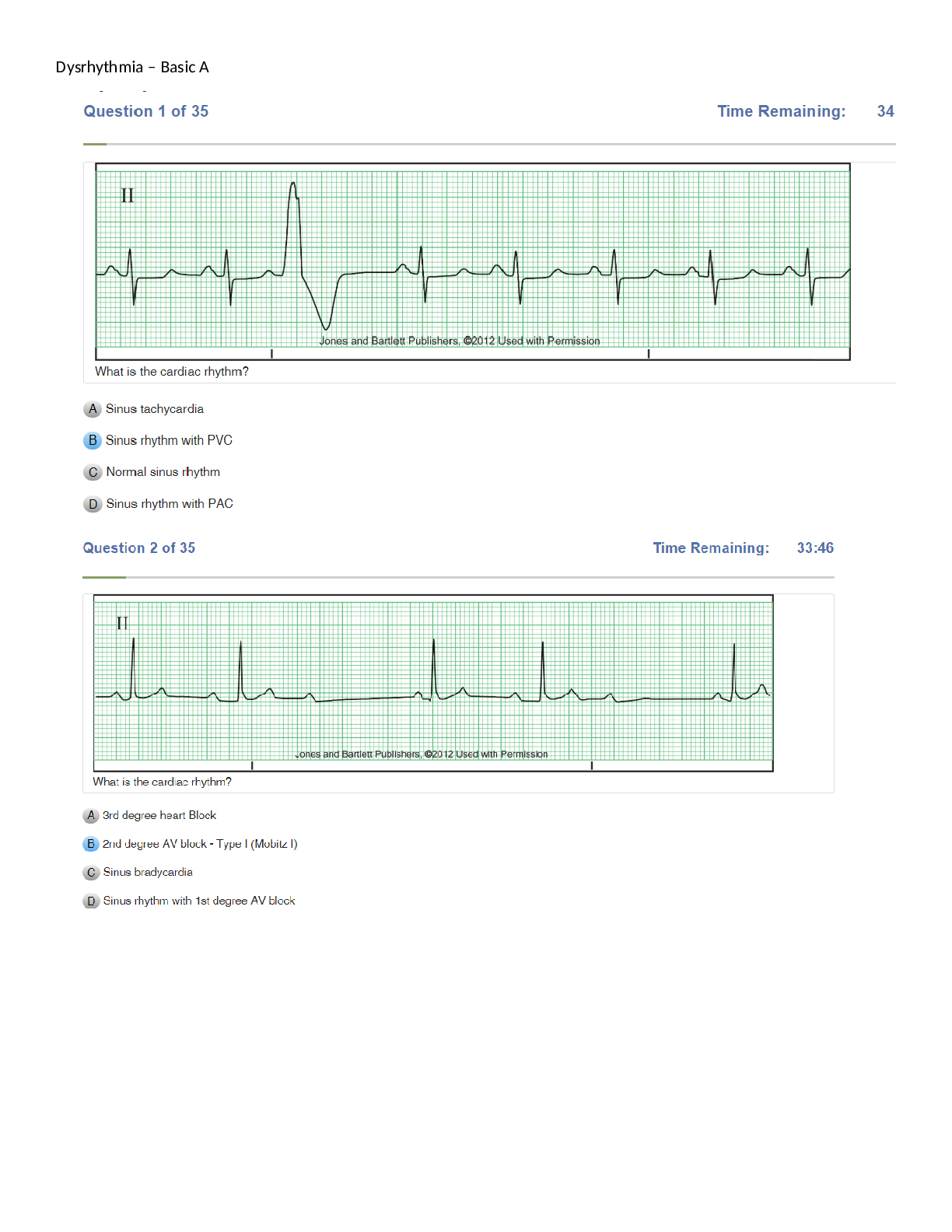
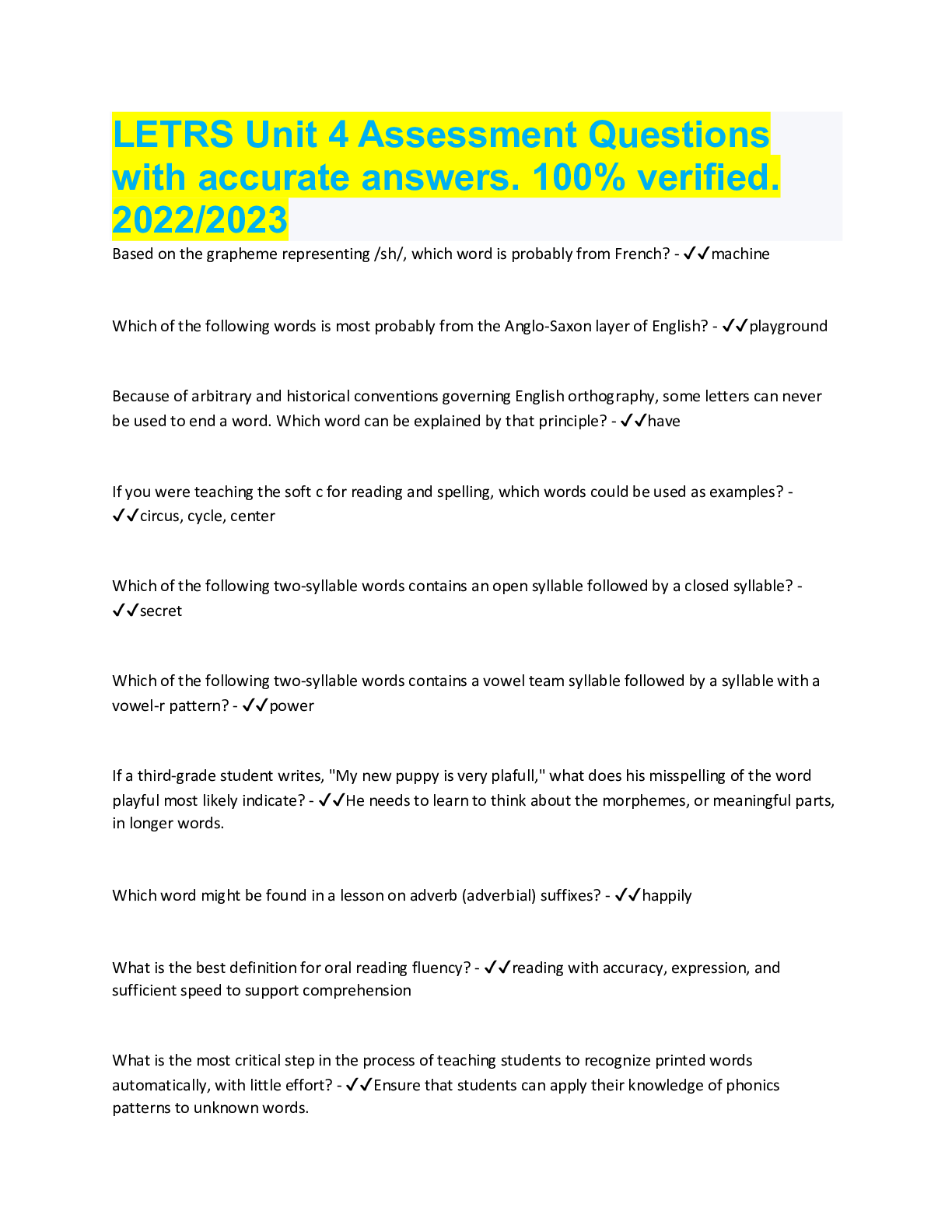


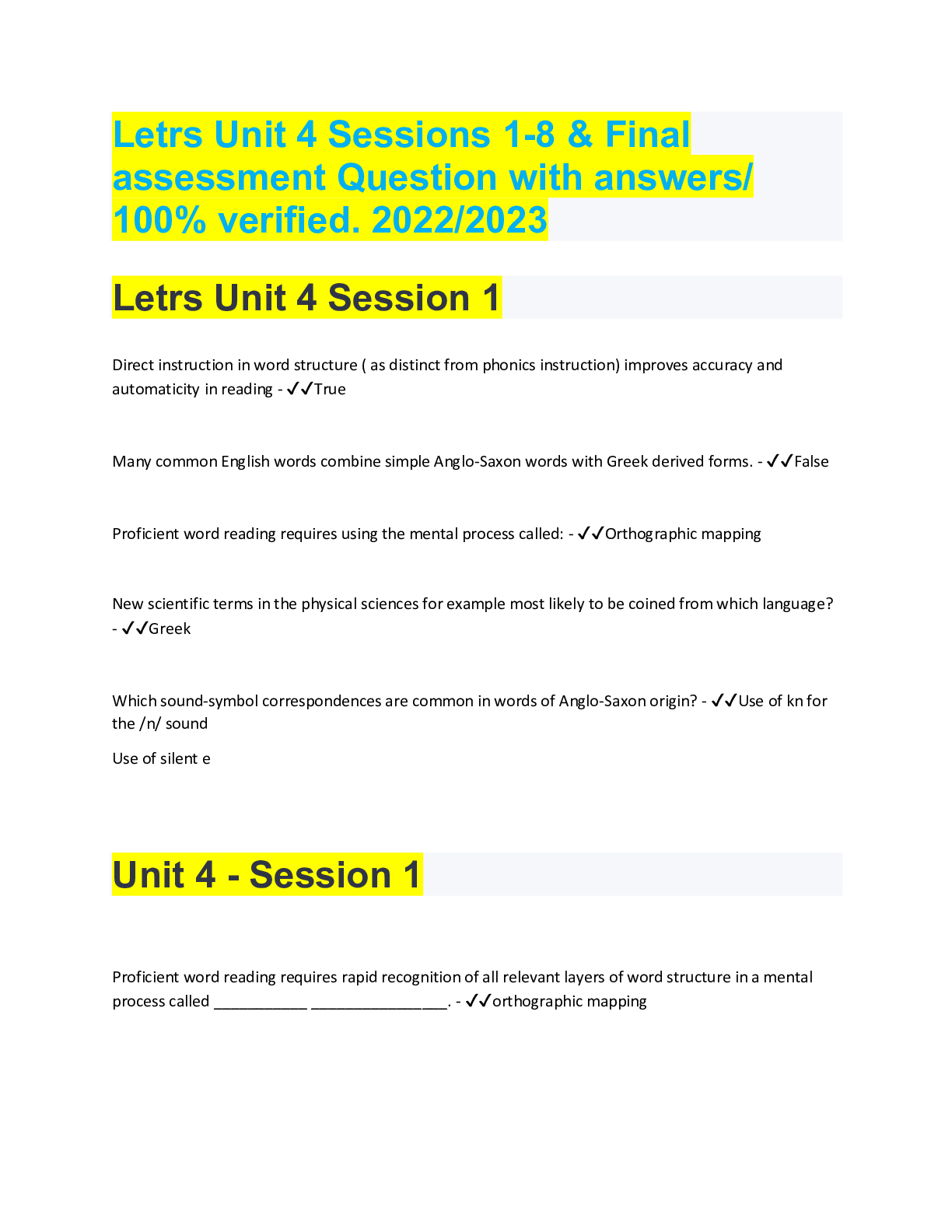
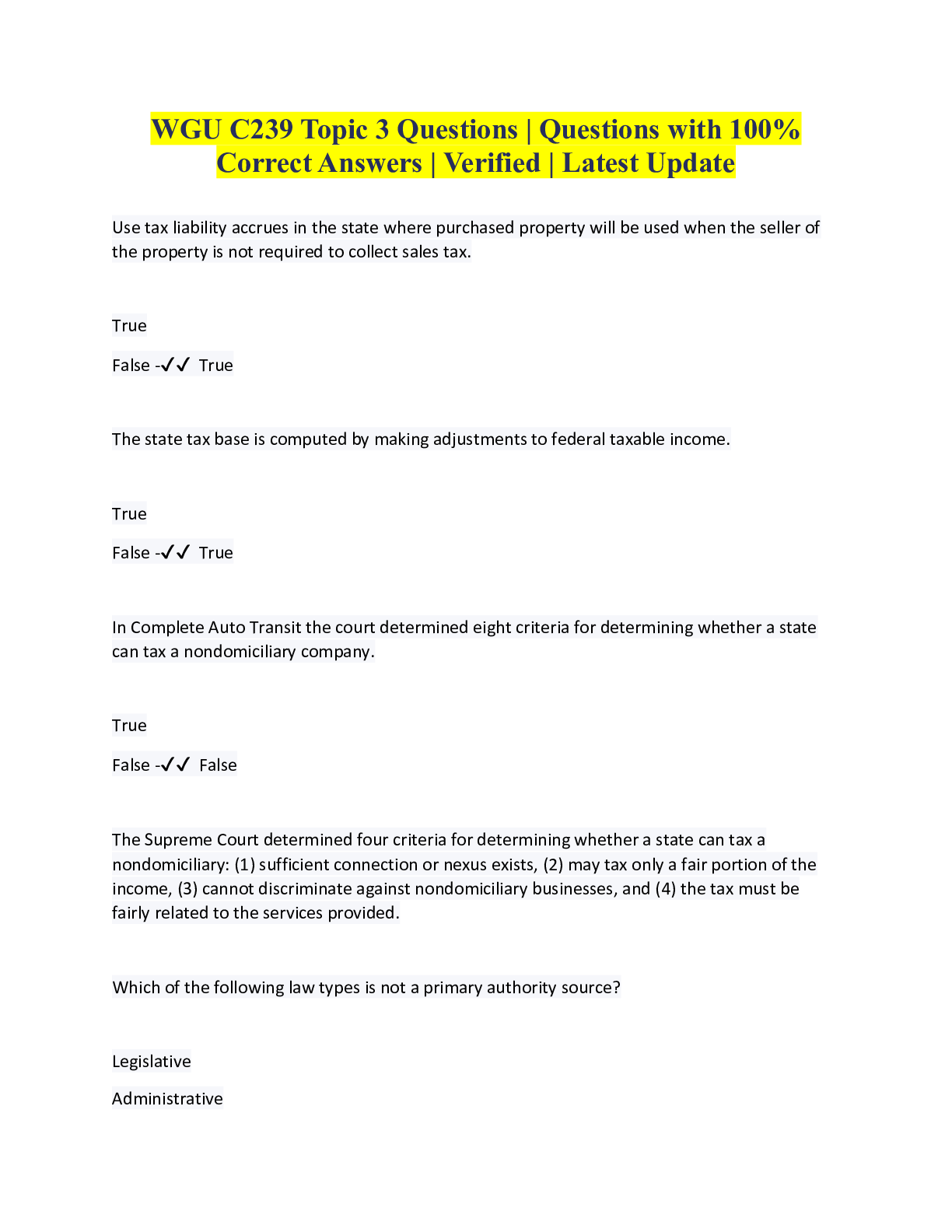
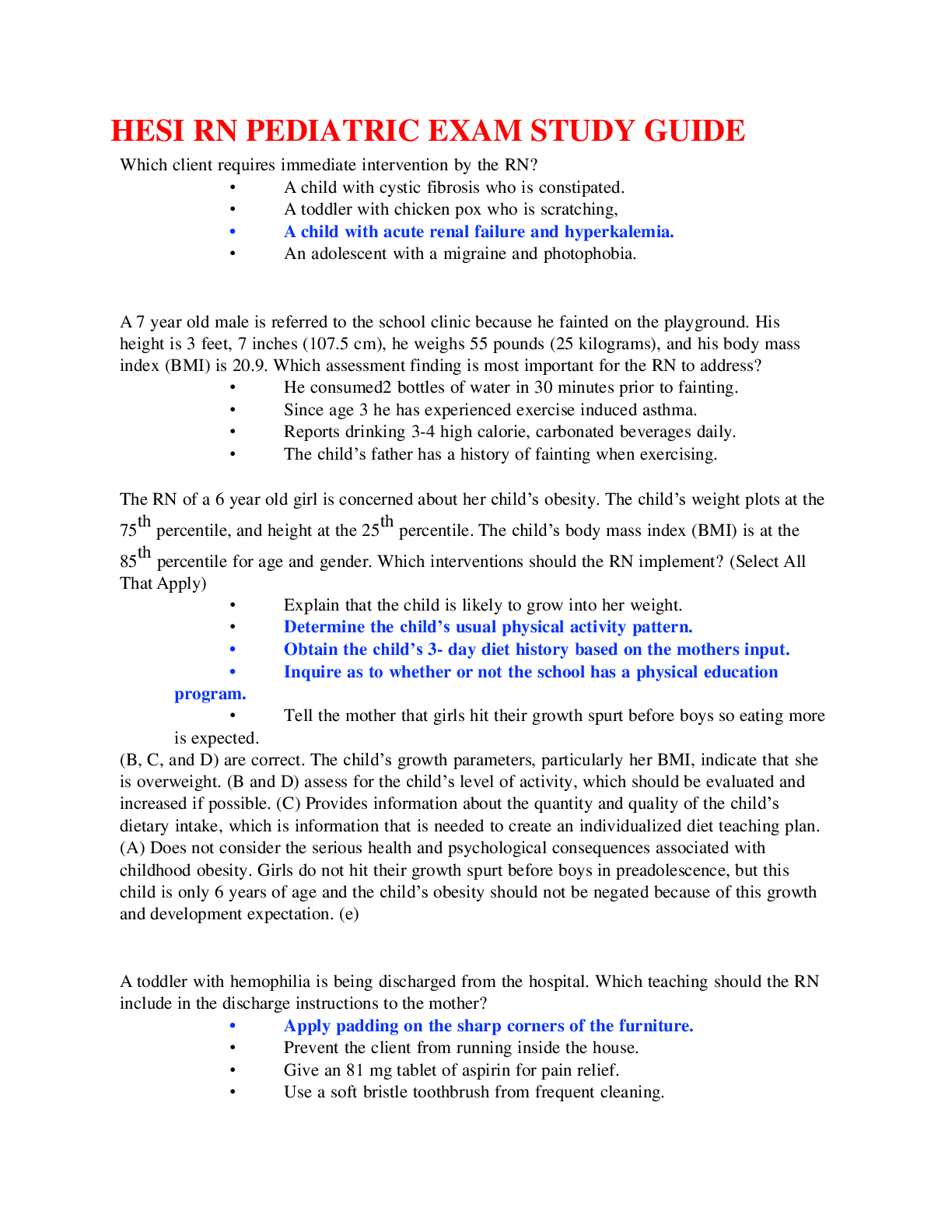

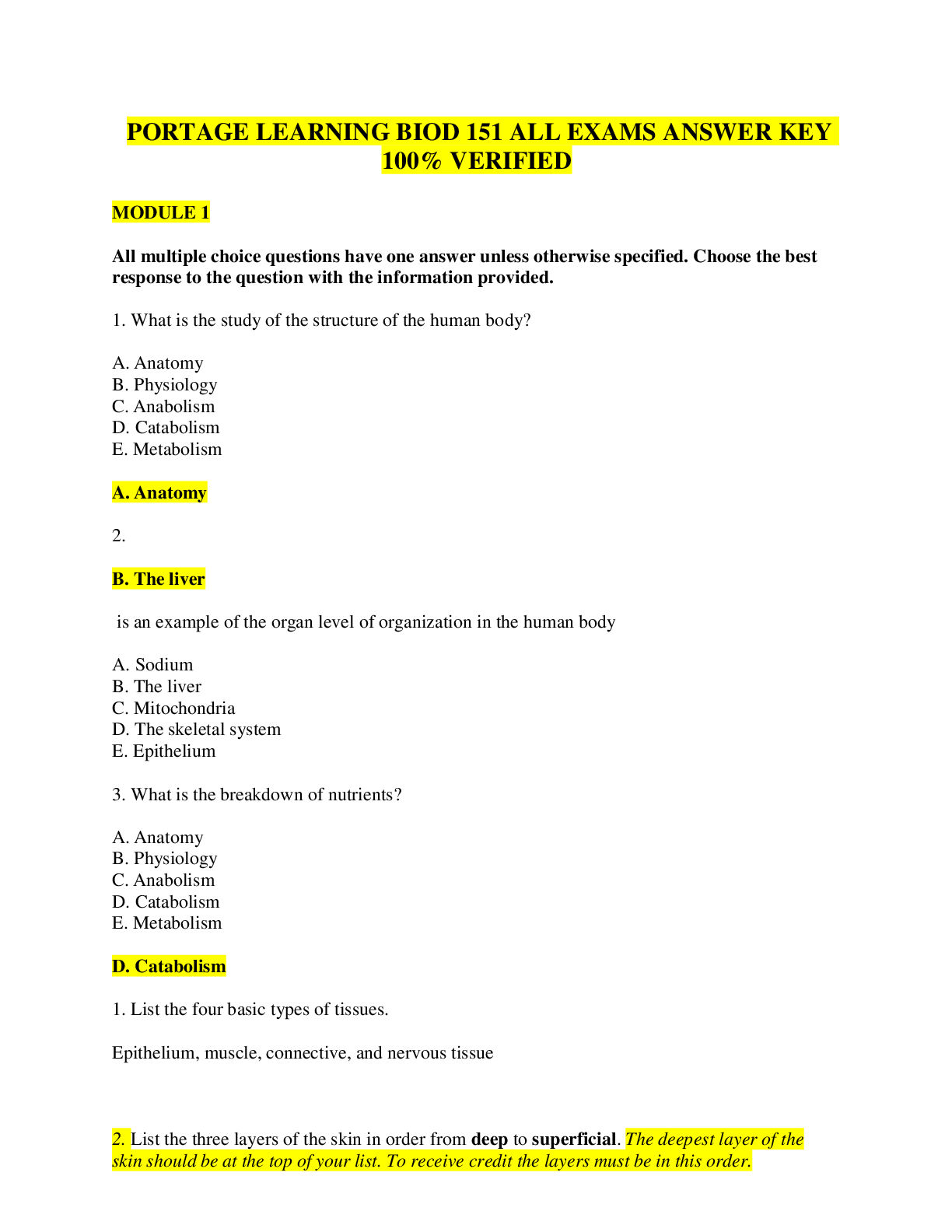

.png)
.png)
.png)
.png)
.png)
.png)

